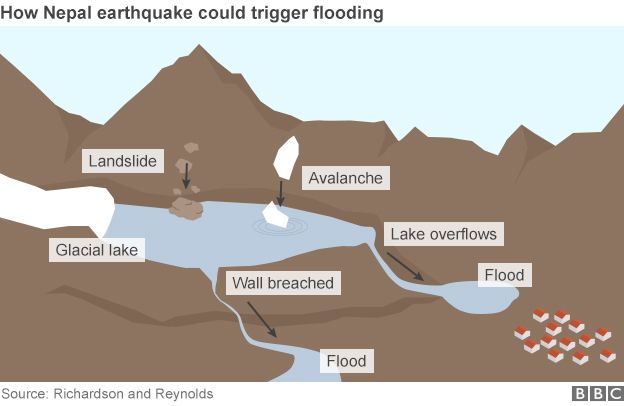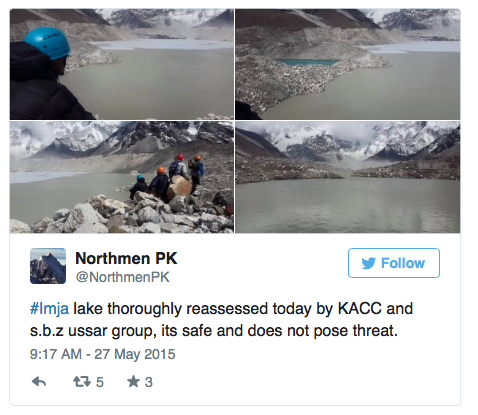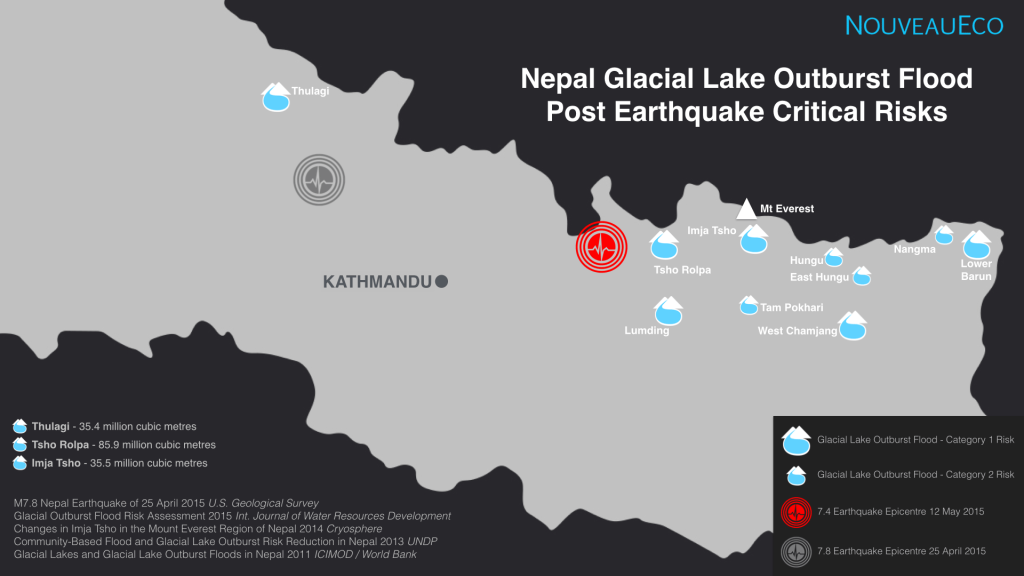Nepal is nestled along the Himalayan range, known as the “Third Pole” of the world due to its concentration of glaciers. Around 10,000 Nepali’s live in the vicinity of three unstable glacial lakes. In the recent past, Nepal has had 24 GLOF incidents (ICIMOD). There are two types of GLOFs. One type occurs when the moraine banks, deposited rock and mud that dam glacial lakes, burst when the earth is disturbed, such as by an earthquake. Another type can occur when glacial lakes rise in volume due to increased glacial melting caused by climate change (ICIMOD).
Earthquakes and GLOFs
The Tsho Rolpa “situated at an altitude of 4,580 meter, is one of the biggest glacial lakes in Nepal and even before the earthquake it was considered to be at high risk” (np.undp.org). GLOFs are damned by moraine banks, which are inherently unstable structures and are easily aggravated by earthquakes or landslides. Although no GLOFs have occurred since the April 25th earthquake, the lack of alert systems would make helping potentially affected individuals particularly difficult.

GLOFs and the Community
These floods wipe out villages, bridges and even hydroelectric plants permanently damaging important infrastructure. GLOFs are an insidious danger, for which there is no warning system. Consequently, floods can wipe out families and culture associated with geographical areas. Some Nepalis situate their homes close to the glacial lakes because of the lucrative tourism they bring (NouveauEco.org). Therefore, these glacier lakes sustain these Nepalis economically. Compounding this situation, certain geographical locations have deep cultural or religious importance for Nepalis, which contributes to families settling near glacial lakes (unisdr.org).
GLOFs and Health
In a post-earthquake setting, with the urgent need to disperse medicines and health care across the country, GLOFs and landslides make reaching remote villages even more burdensome. Therefore, GLOFs not only impact the landscape of Nepal, but jeopardize the safety and health of Nepalis. Much like monsoons, GLOFs can destroy farmland and kill livestock, creating food insecurity. Food insecurity can have a significant impact on the health of individuals, making them more susceptible to illnesses.
What can be done to address GLOF’s impact on Nepal post-earthquake?
Interventions to abate the disastrous effects of GLOFs are split into two factions: structural and non-structural, both of which began in earnest in the early 2000s (preventionweb.net). The compilation of data evaluating the strategies to mitigate the risks of GLOFs is still in the early stages.
Structural Intervention
- Building artificially reinforced channels that lower a lake’s volume, so that it does not overflow.
Non-Structural Interventions
- Remote sensing that is used to map and record the status of glacial lakes as a preliminary step for creating an alert system.
- Alert system based on radar level and water content sensors (np.undp.org).
- Educating the community about the risks of living near glacial lakes, so that they can be prepared in times of emergency.
- This intervention would have to be carefully crafted to exhibit cultural sensitivity for geographic locations (especially near the Himalayas) that are spiritually significant.
- Creating a unified system for tracking and alerting others about the status of glacial lakes.

Groups such as KACC (Khumba Alpine Conservation Council) have made efforts post-earthquake, to observe the status of glacial lakes.
Who is currently working on these issues?
The International Centre for Integrated Mountain Development (ICIMOD) has compiled data post-earthquake, gauging the risks of various glacial lakes around Nepal. They also contribute to structural interventions.
- Publishing a “standardized glacial lake inventory,” which will help with GLOF risk assessment (preventionweb.net).
- Working with government agencies to construct draining channels.

The United Nations Development Programme (UNDP) in partnership with the Government of Nepal, the High Mountain Glacial Watershed Program, and ICIMOD have allocated a total of $26,652,510 to combatting the risks of GLOFs through their “community-based GLOF risk-reduction” programme (UNDP.com). Their goals include:
- Artificially lowering the lake level via controlled drainage.
- Strengthened connectivity of GLOF monitoring and early warning systems.
- Establishing a system owned and operated by the local communities themselves, interlinked with district and national level Emergency Operation Centres (preventionweb.net).
- All vulnerable communities in at least 1 GLOF-prone district are trained in flood preparedness and GLOF risk mitigation.
NouveauEco, a consulting NGO that focuses on the effects of climate change, releases information, and info-graphics (like the one below):
- Consulting team identifies the “immediate and long term economic risks posed by climate change so that organisations can make the best resource allocations to support adaptation and achieve meaningful mitigation” (NouveauEco.org).
- Using info-graphics to alert locals and international first responders of the risks of the area (NouveauEco.org).

